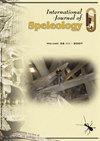微生物介导的碳酸盐溶解和沉淀;拟定一份移地模拟洞穴栽培实验的协议
IF 1.3
4区 地球科学
Q3 GEOSCIENCES, MULTIDISCIPLINARY
引用次数: 4
摘要
地下方解石的溶解和沉淀通常被认为是严格意义上的地球化学过程。在这些过程中,微生物的积极参与在文献中通常被低估了,因为洞穴中一般的营养不良条件,除了特殊的洞穴条件,如硫化物洞穴和月乳矿床,在这些条件下,微生物的存在可能在矿物沉积中起关键作用。在这里,我们研究了来自斯洛文尼亚Postojna洞穴的微生物可能参与了碳酸盐溶解(溶石)和沉积(造岩)。从水文不同滴注点下方的小池中取样微生物,并在10和20°C的抛光石灰石片上在洞穴模拟条件下孵育2周和14周。然后在扫描电子显微镜下观察片剂,以研究微生物与岩石的相互作用。我们的实验表明,存在各种微生物形态,通常与细胞外聚合物质有关,牢固地附着在表面上。遗憾的是,我们使用96%和70%乙醇的表面灭菌方法无法在实验石灰石片的深层自然裂缝中建立完全的无菌条件。尽管如此,我们的结果模拟了环境微生物与石灰岩的相互作用。观察到明显的方解石溶解和沉淀与这些微生物有关。此外,我们展示了在营养耗尽的生长条件下微生物在富硅沉淀物中埋藏的证据,我们建议微生物参与环境条件下的二氧化硅动员可能是一个普遍但经常被忽视的现象。我们的发现对微生物介导洞穴碳酸盐溶解和沉淀具有重要意义,包括在洞穴主题和史前洞穴艺术中保存过去的气候代理信号。建议改进方法和进一步的工作,以便在未来进行更强大的异地栽培实验,促进对该主题的更好和更详细的研究。本文章由计算机程序翻译,如有差异,请以英文原文为准。
Microbially-mediated carbonate dissolution and precipitation; towards a protocol for ex-situ, cave-analogue cultivation experiments
Subterranean calcite dissolution and precipitation are often considered as strictly geochemical processes. The active involvement of microbes in these processes is commonly underestimated in the literature due to general oligotrophic conditions in caves, except in particular cave conditions, such as sulfidic caves and moonmilk deposits, where the presence of microbes likely plays a key role in mineral deposition. Here, we study the possible involvement of microbes from Postojna Cave, Slovenia, in carbonate dissolution (litholysis) and precipitation (lithogenesis). Microbes were sampled from small pools below hydrologically diverse drip sites and incubated on polished limestone tablets at 10 and 20°C for 2 and 14 weeks under cave-analogue conditions. The tablets were then observed under scanning electron microscope to investigate microbe–rock interactions. Our experiments showed the presence of various microbial morphotypes, often associated with extracellular polymeric substances, firmly attached on the surfaces. Unfortunately, our surface sterilization method using 96% and 70% ethanol could not establish the complete aseptic conditions in deep natural cracks in the experimental limestone tablets. Nonetheless, our results emulate the interaction of environmental microbes with limestone rock. Conspicuous calcite dissolution and precipitation were observed in association with these microbes. Furthermore, we show evidence of entombment of microbes in a Si-rich precipitate during nutrient-depleted growth conditions and we suggest that microbial involvement in silica mobilization under ambient conditions may be a widespread and often overlooked phenomenon. Our findings have important implications for microbial-mediation of cave carbonate dissolution and precipitation, including the preservation of past climate proxy signals in speleothems and prehistoric cave art. Improvements to the methodology and further work are suggested to enable more robust ex-situ cultivation experiments in the future, facilitating better and more detailed research into this topic.
求助全文
通过发布文献求助,成功后即可免费获取论文全文。
去求助
来源期刊

International Journal of Speleology
地学-地球科学综合
CiteScore
3.10
自引率
23.10%
发文量
12
审稿时长
>12 weeks
期刊介绍:
The International Journal of Speleology has the aim to get cave and karst science known to an increasing number of scientists and scholars. The journal therefore offers the opportunity to all scientists working in and on karst to publish their original research articles or their review papers in an open access, high quality peer reviewed scientific journal at no cost. The journal offers the authors online first, open access, a free PDF of their article, and a wide range of abstracting and indexing services.
 求助内容:
求助内容: 应助结果提醒方式:
应助结果提醒方式:


